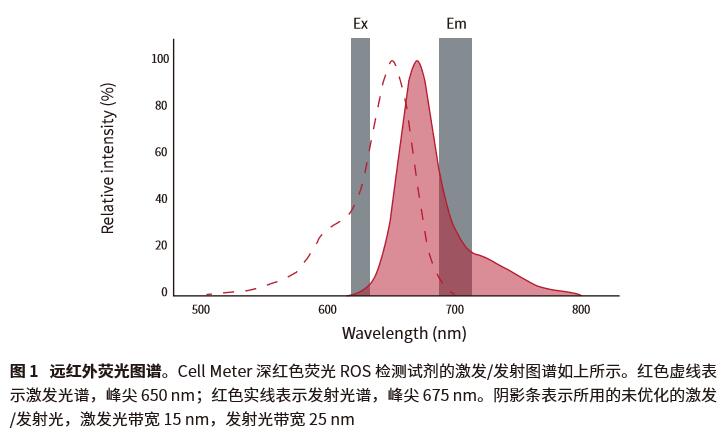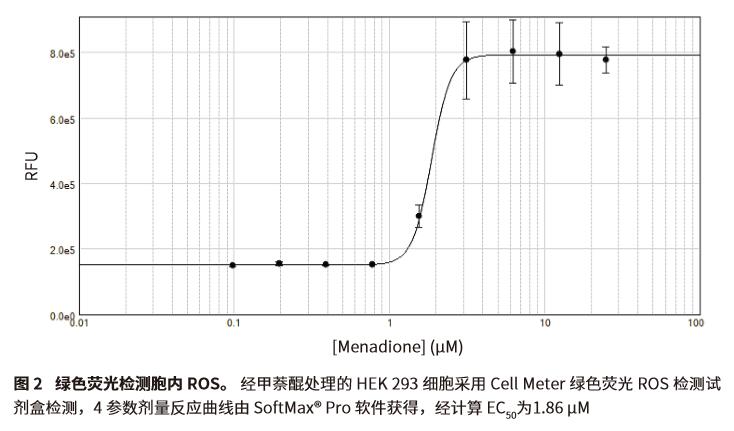introduction Reactive oxygen species (ROS) are a class of chemically reactive oxygen-containing molecules produced by cellular aerobic metabolism, which are involved in various physiological activities such as cell signal transduction, immune defense, and maintenance of homeostasis. However, when the cells are under environmental stress, the level of intracellular ROS will rise sharply and cause oxidative damage of nucleic acids, proteins and lipids [1], causing many physiological and pathological changes, such as male infertility, cancer, etc. Etc. [2]. Advantage • One-step homogeneous fluorescence for rapid detection of intracellular ROS • Ultra-cold PMT further reduces background noise and enhances experimental performance • Spectral Optimization Wizard optimizes excitation and emission wavelengths material • Cell MeterTM Fluorescent Intracellular Total ROS Activity Assay Kit* Dark Red Fluorescent* (AAT Bioquest cat. #22903) method HEK 293 cells were plated in 96-well cell culture plates at 10,000 cells per well and cultured at 37 °C for 24 hours. The cells were then treated with a menaquinone concentration gradient for 1 hour with a starting concentration of menadione of 25 μM and a dilution factor of 2. The cells were finally treated with Cell Meter Deep Red Fluorescent ROS Assay Reagent or Cell Meter Green Fluorescent ROS Assay Reagent and incubated at 37 °C for 30 minutes. result Menadione causes intracellular ROS content to accumulate by blocking different parts of the mitochondrial electron transport chain [4], so the intracellular ROS content increases as its concentration increases. Both the Cell Meter Deep Red Fluorescent ROS Assay Kit and the Green Fluorescent ROS Assay Kit are able to derive the menadione dose response curve and have a similar EC50 (Figure 2, 3). The excitation/emission wavelength used for far infrared analysis is Spectral Optimization Wizard. Optimization, the optimal Z factor in this experiment can be obtained (Table 2). in conclusion For the intracellular fluorescence detection of ROS content experiments, the use of the SpectraMax iD5 multi-function microplate reader combined with SoftMax® Pro analysis software is a very powerful tool. The Spectral Optimization Wizard and Read Height Optimization in the software automatically optimize the experimental conditions for better experimental results. Although the SpectraMax iD5 is effective for green fluorescence detection and far-infrared fluorescence detection of intracellular ROS content, the latter combined with the excitation/emission wavelength optimization setting exhibits a superior Z factor than the former. References 1. Hancock, JT, R. Desikan, and SJ Neill. "Role of reactive oxygen species in cell signalling pathways." Biochem Soc Trans. (2001) May; 29 (Pt 2): 345-50. Colorful Safe Boxes,Digital Lock Safes,Combination Lock Safe,Small Hotel Safes Hebei Yingbo Safe Boxes Co.,Ltd , https://www.ybsafebox.com
Intracellular ROS levels are usually detected using fluorescent probes, especially green fluorescent probes. However, since green fluorescence detection and imaging are susceptible to cellular autofluorescence [3], far/near infrared dyes are often used to detect ROS levels to avoid interference from autofluorescence.
The SpectraMax® iD5 Multi-Purpose Microplate Reader features ultra-cold PMT and “2X2†grating optical path design to reduce signal background and reduce stray light, providing a wider dynamic range and higher sensitivity for far-infrared fluorescence detection.
Here we show how to use the SpectraMax iD5 Multi-Purpose Microplate Reader and 2 Fluorescence Detection Kits for intracellular ROS content analysis. With the help of the Spectral Optimization Wizard, we optimized the different wavelength combinations of excitation and emission under far infrared analysis and finally compared the performance of green fluorescence detection and far infrared fluorescence detection.
• Cell MeterTM Fluorescent Intracellular Total ROS Activity Assay Kit* Green Fluorescent* (AAT Bioquest cat. #22900)
• HEK293 cells (AATC cat. #CRL-1573)
• Menadione (Sigma cat. #M9429-25G)
• 96-well tissue culture plate with black-edged bottom (Greiner cat. #655087)
• SpectraMax iD5 Multi-Mode Microplate Reader (Molecular Devices cat. #iD5)
Because the excitation and emission wavelengths recommended by the Cell Meter Deep Red Fluorescent ROS Detection Kit are too close together (658/675 nm), they are not compatible with the SpectraMax iD5 Multi-Purpose Microplate Reader, so the excitation/emission of this experiment is used. The estimated 625/700 nm is sufficient for the excitation/emission bandwidth to be sufficient and produces sufficient fluorescence (Figure 1).
SoftSpec® Pro software's Spectral Optimization Wizard automatically calculates the appropriate excitation/emission wavelength for far-infrared analysis, and the Read Height Optimization setting finds the right reading height. The wavelength and PMT gain settings used in the experiment are shown in Table 1, and the data and images were generated using SoftMax® Pro software. 




2. Ogawa K, Suzuki K, Okutsu M, Yamazaki K, Shinkai S. The association of elevated reactive oxygen species levels from neutrophils with low-grade inflammation in the elderly. Immunity & Ageing: I & A. 2008; 5:13. Doi:10.1186/ 1742-4933-5-13.
3. Lin, Michael Z. "Beyond the rainbow: new fluorescent proteins brighten the infrared scene." Nature Methods 8.9 (2011): 726.
4. Kolesova, GM, LV Karnaukhova, and LS IaguzhinskiÄ. "Interaction of menadione and duroquinone with Q-cycle during DTdiaphorase function." Biokhimiia (Moscow, Russia) 56.10 (1991): 1779 -1786.